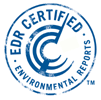Chimneys - When a Flue is Too Big
Most older homes, especially in the Northeast, use masonry chimneys to vent their combustion appliances. During the past ten years, many old furnaces and boilers have been gradually replaced with higher-efficiency models that use PVC sidewall vents. When an older furnace is disconnected from a masonry chimney, it may leave behind a so-called "orphaned" water heater, attached to a flue that is now oversized.
However, when it comes to sizing a flue, bigger isn't always better. Oversized flues can contribute to at least three problems: poor draft, chimney corrosion, and freeze/thaw damage to the chimney.
Anemic Draft - When a gas water heater fires up, it may not have enough heat in its flue gases to push through the large volume of cold air in an oversized flue. Today's appliances are more energy efficient than older models, extracting more heat from the flue gas. Since cooler flue gas is less buoyant, newer appliances are usually less forgiving of oversized flues. Appliances attached to oversized flues are more likely to backdraft, increasing the danger of introducing carbon monoxide inside a home.
Flue gas contains a great deal of moisture. As long as the moisture leaves the building as vapor, all is well. But an oversized flue stays cool, encouraging the flue gas to condense. "For the flue gas from a natural-gas flame, the dew point is 136 degrees," says Carl Saunders, director of training at Utica Boilers in Utica, N.Y. "With a big masonry chimney, you won't have much chance of keeping the gas about the dew point."
Flue-gas condensate, which often contains nitric and sulfuric acid, can corrode bricks, mortar, and metal, including some types of stainless steel. Dried flue-gas condensate is a crumbly white powder containing corrosive salts; this powder can accumulate, especially in horizontal vent pipes, until the vent is blocked.
If a chimney is particularly large and cold, many gallons of water can condense every week, saturating the masonry and adjacent plaster. "In the cold part of the chimney, the condensate goes through freeze/thaw cycles, which can force the bricks apart," Saunders says. "Sometimes you can see that the bricks are coming loose, or the whole chimney can be cocked."
Of course, water heaters are not the only appliances that can have problems with flue-gas condensation. Oversized mid-efficiency furnaces and boilers are also susceptible to the problem, since short cycling can prevent a chimney from every warming up. With boilers, flue gases can condense when the return-water temperature is too low, keeping the boiler too cool. Finally, flue gas from any combustion appliance can condense wherever there is a long horizontal run of metal vent pipe.
False Economy - These days, most installers are savvier at identifying venting problems than they were in the past. Yet the orphaned water heater problem may be worsening, as appliances continue to become more energy efficient. "You'd think everyone would understand this by now," says Jeri Donadee, vice president of H.B. McClure Co., a heating contractor in Harrisburg, PA. "But I think this problem is getting worse. There are more than a few idiots out there installing water heaters. Lining a chimney can cost anywhere from $400 to $1,200 and a lot of customers don't want to spend the money to do it right."
Sizing by code - Because so many factors affect whether a chimney will draw, rules of thumb are of little use when it comes to assessing a flue. Even a 6X6 flue, in some circumstances, may be too large to vent a water heater. To size a flue, both the appliance manufacturer and the relevant code books must be consulted.
The most important venting code for gas appliances is NFPA 54, the National Fuel Gas Code, which was most recently revised in 1999. "The National Fuel Gas Code reads like a law text," says Donadee. Once a contractor wades through the dense prose, however, the code will provide guidance. "There are a lot of variables - whether the chimney is interior or exterior, the total height of the chimney, the BTUs going in, and whether it is a Category 1, 2, or 3 appliance," says Donadee.
According to the national Fuel Gas Code, the maximum size of an appliance vent depends not only on whether a chimney is exposed to the weather, but also on the climate. "Outside chimneys in Vermont don't work as well as outside chimneys in Alabama," says Jay Mullowney, manager of technical services at Vermont Gas Systems in Burlington, VT.
Flue gas is about to get less buoyant. The National Appliance Energy Conservation Act, passed in 1987, sets minimum energy standards for water heaters. On January 17, 2001, in the waning days of the Clinton administration, the Department of Energy (DOE) published a new rule establishing more stringent energy standards for water heaters; it becomes effective in January 2003. The new standards raise the minimum energy factor (EF) for a 40-gallon gas water heater from 0.54 to 0.59.
Some critics including the Gas Appliance Manufacturers Association (GAMA), worry that the DOE is promulgating these more stringent standards without considering the need to revise venting codes to account for the new water heaters' cooler flue-gas temperatures. "GAMA, on behalf of the manufacturers who make residential water heaters, has filed a petition for reconsideration of the new standards," says Joe Mattingly, general counsel at GAMA. "We do believe that if this new rule is implemented, there will have to be some modifications to the National Fuel Gas Code for venting." Even if the codes are revised, the problem of oversized flues may worsen once the new water heaters hit the market, since many installers don't stay current with code changes.
Warning Signs - Remodelers should be alert to signs that an appliance may be connected to an oversized flue. Clues include saturated or stained drywall near a chimney, peeling wallpaper, efflorescence on chimney bricks, brick spalling, crumbling mortar, and corrosion in metal vent pipes. If a problem is suspected, the first step is to check the venting requirement provided by the water heater manufacturer. Manufacturers are required to provide both a minimum and a maximum vent size.
If the flue in an existing masonry chimney is too large, there are two solutions. "You either line the chimney or change the water heater to a sidewall-vented unit," says Donadee. Lining the chimney usually requires the installation of a 3- or 4-inch diameter aluminum or stainless steel liner, all the way up to the chimney top.
Since a venting problem can lead to carbon monoxide poisoning, sizing a gas vent is no time for guessing. The problem of orphaned water heaters has led to at least one class-action lawsuit, which was settled in July' 1999 when a gas utility, MichCon, agreed to subsidize the cost of lining the plaintiffs' chimneys. "A deteriorated chimney can be easily replaced," says Donadee. "But people can die. If you turn your back on the code, you're risking someone else's life."
- by Martin Holladay - The Home Inspector/Housing Inspection Foundation


